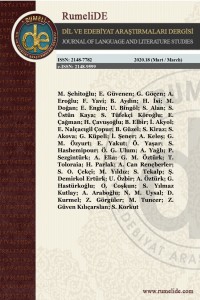Öz
Bu çalışma, Betimleyici Çeviribilim çerçevesinde, John Steinbeck’in To A God Unknown eserindeki ekolojiye ilişkin kültüre özgü öğelerin çevirisinde kullanılan çeviri yöntemlerinin dağılımlarını nicel verilerle tarihsel olarak incelemeyi amaçlamaktadır. Canlı çevre betimlerinin oldukça yoğun olduğu bu eserin çevirisinde de aynı ekolojik tutumun var olması beklenmektedir. Çalışmada, eserdeki bir bölümde kültüre özgü bir öğe olarak değerlendirilen ekolojiye ilişkin sözcükler, 1955, 1985 ve 2019 yılında yapılmış olan üç çeviride, anlam kategorilerine ayrılarak karşılaştırılmıştır. Ekolojiye ilişkin unsurlar flora, fauna, yer adları, doğal oluşum, hava ve iklim koşulları ve doğal afet kategorileri altında incelenmiştir. Çalışmanın bulguları, üç ayrı dönemin çevirisinde en fazla sözcüğü sözcüğüne çeviri yönteminin kullanıldığını ve bunu sırasıyla yerlileştirme ve yabancılaştırma yöntemlerinin takip ettiğini göstermiştir. Sonuçlar, çevirmenlerin, özellikle 2019’daki çeviriyi yapan çevirmenin, kaynak kültürdeki ekolojik unsurların çeşitliliğinin ve özelliklerinin bilincinde olduğunu ve bu unsurları hedef kültüre ekolojik duyarlılıkla aktarma çabasında olduklarını ortaya koymuştur.
Anahtar Kelimeler
Ekoloji çevirisi çeviri yöntemleri kültüre özgü öğelerin çevirisi yerlileştirme yabancılaştırma
Kaynakça
- Aksoy, N. Berrin. (2020). Insights into a new paradigm in translation: Eco-translation and its reflections. Babel. Online-First Articles, 1-17.
- Axielá, Javier Franco. Culture-specific items in translation. In R. Alvares and M. C.- A Vidal Translation Power Subvention, 8, 52-78, Clevedon: Multilingual Matters. 1996.
- Cronin, Michael. Eco-Translation: Translation and Ecology in the Age of the Anthropocene. Routledge, 2017.
- Duranti, A. (1997). Linguistic Anthropology. Cambridge: Cambridge University Press.
- Hart, E. Richard. (1997). Steinback on man and Nature: A Philosophical Reflection. In Beegel, Susan F. Beegel, Susan Shillinglaw, Wesley N. Tiffney (Eds.). Steinbeck and the Environment: Interdisciplinary Approaches. Tuscaloosa: University of Alabama Press. 43-52.
- Harvey, M. (2000). A beginner's course in legal translation: the case of culture-bound terms. Retrieved December 3, 2019 from http://www.tradulex.org/Actes2000/harvey.pdf
- Kansu-Yetkiner, N., Yavuz, Y., Duman, D. (2018). Erken Cumhuriyet döneminden günümüze çocuk edebiyatındaki çevre odaklı kültürel sözcüklerin çevirisine niceliksel bir yaklaşım. Dilbilim Araştırmaları Dergisi, 2, 57-82.
- Klaver, Rosanne. (2018). Preserving ecologically beneficial texts: Towards an applied approach to ecotranslation. Unpublished MA Thesis. Leiden University.
- Newmark, P. (1988). Textbook of Translation. Oxford: Pergamon Press.
- Nida, E.A. (1964). Towards A Science of Translation, With Special Reference to Principles and Procedures Involved in Bible Translating. Leiden: E.J. Brill.
- Nida, E.A., & Taber, C.R. (1982). The Theory and Practice of Translation. Leiden: E.J. Brill.
- Stibbe, A. (2015). Ecolinguistics: Language, Ecology and the Stories We Live By. Abingdon: Routledge.
- Vermeer, H. (1992). Is translation a linguistic or a cultural process? Ilha do Desterro, 18, 37-49.
- Cao, Lijuan. (2011). Translation ecology. Perspectives, 19 (1), 89-92.
Öz
This article uses the Descriptive Translation Studies framework to examine the Turkish translations of To A God Unknown by John Steinbeck, with a view to reveal the diachronic distribution of translation methods formulated in the transfer of culture-specific items related to ecology through quantitative data. As a novel with its vivid descriptions of natural surroundings, the translations of it are expected to demonstrate the same ecological stance of the source text. This research examines a corpus consisting of one chapter from three translations of To A God Unknown conducted in 1955, 1985, 2019 for presenting the profile of the translations by comparing the translators’ methods while translating ecology as a culture-specific item through a semantic categorization. The findings demonstrate that for these ecology-related items under the categories of flora, fauna, names of the places, land forms, weather conditions, and natural formations, literal translation is the most frequently adopted method in three translations followed by domestication and foreignization, respectively. The results show that the translators, especially the one translating the latest version, seem to be aware of the diversity and specificity of the ecological items in the source culture and try to transfer each one with ecological sensitivity to the target culture.
Anahtar Kelimeler
Translating ecology translation methods translation of culture-specific items domestication foreignization
Kaynakça
- Aksoy, N. Berrin. (2020). Insights into a new paradigm in translation: Eco-translation and its reflections. Babel. Online-First Articles, 1-17.
- Axielá, Javier Franco. Culture-specific items in translation. In R. Alvares and M. C.- A Vidal Translation Power Subvention, 8, 52-78, Clevedon: Multilingual Matters. 1996.
- Cronin, Michael. Eco-Translation: Translation and Ecology in the Age of the Anthropocene. Routledge, 2017.
- Duranti, A. (1997). Linguistic Anthropology. Cambridge: Cambridge University Press.
- Hart, E. Richard. (1997). Steinback on man and Nature: A Philosophical Reflection. In Beegel, Susan F. Beegel, Susan Shillinglaw, Wesley N. Tiffney (Eds.). Steinbeck and the Environment: Interdisciplinary Approaches. Tuscaloosa: University of Alabama Press. 43-52.
- Harvey, M. (2000). A beginner's course in legal translation: the case of culture-bound terms. Retrieved December 3, 2019 from http://www.tradulex.org/Actes2000/harvey.pdf
- Kansu-Yetkiner, N., Yavuz, Y., Duman, D. (2018). Erken Cumhuriyet döneminden günümüze çocuk edebiyatındaki çevre odaklı kültürel sözcüklerin çevirisine niceliksel bir yaklaşım. Dilbilim Araştırmaları Dergisi, 2, 57-82.
- Klaver, Rosanne. (2018). Preserving ecologically beneficial texts: Towards an applied approach to ecotranslation. Unpublished MA Thesis. Leiden University.
- Newmark, P. (1988). Textbook of Translation. Oxford: Pergamon Press.
- Nida, E.A. (1964). Towards A Science of Translation, With Special Reference to Principles and Procedures Involved in Bible Translating. Leiden: E.J. Brill.
- Nida, E.A., & Taber, C.R. (1982). The Theory and Practice of Translation. Leiden: E.J. Brill.
- Stibbe, A. (2015). Ecolinguistics: Language, Ecology and the Stories We Live By. Abingdon: Routledge.
- Vermeer, H. (1992). Is translation a linguistic or a cultural process? Ilha do Desterro, 18, 37-49.
- Cao, Lijuan. (2011). Translation ecology. Perspectives, 19 (1), 89-92.
Ayrıntılar
| Birincil Dil | İngilizce |
|---|---|
| Konular | Dilbilim, Sanat ve Edebiyat |
| Bölüm | Türk dili, kültürü ve edebiyatı |
| Yazarlar | |
| Yayımlanma Tarihi | 21 Mart 2020 |
| Yayımlandığı Sayı | Yıl 2020 Sayı: 18 |


